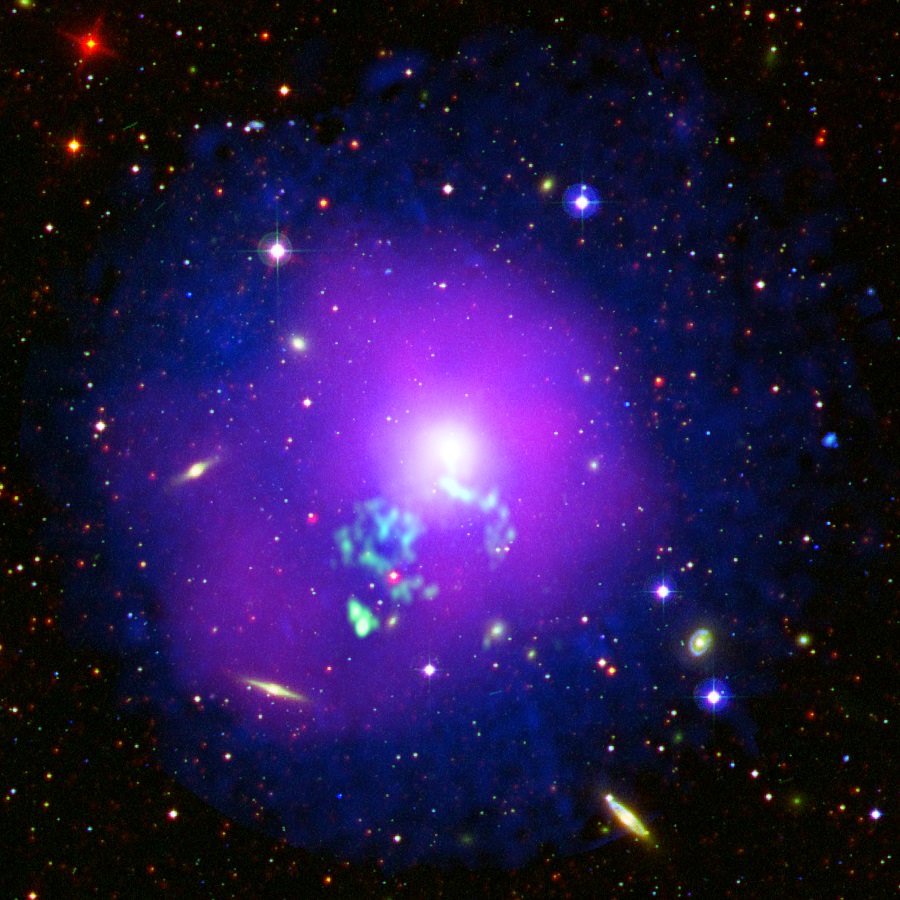So galaxy group NGC 5044 was just sitting quietly by itself a few million years ago when galaxy NGC 5054 decided to pass right through it. That close encounter finished long ago, but the ricochet is still visible in telescopes as astronomers spotted hot gas rippling through the host galaxy.
“Galaxies are social beasts that are mostly found in groups or clusters – large assemblies of galaxies that are permeated by even larger amounts of diffuse gas. With temperatures of 10 million degrees or more, the gas in galaxy groups and clusters is hot enough to shine brightly in X-rays and be detected by ESA’s XMM-Newton X-ray observatory,” the European Space Agency stated.
“As galaxies speed through these gigantic cauldrons, they occasionally jumble the gas and forge it into lop-sided shapes. An example is revealed in this composite image of the galaxy group NGC 5044, the brightest group in X-rays in the entire sky.”
Fresh observations from XMM-Newton (in blue) are visible in this composite image with other pictures from the Wide-field Infrared Survey Explorer, the Digitized Sky Survey (optical) and Galex (near-ultraviolet).
Publication of this research was accepted in MNRAS and is currently available on prepublishing site Arxiv. The lead author is Ewan O’Sullivan, a visiting scientist at the Harvard-Smithsonian Center for Astrophysics in Cambridge, Mass.


I liked this image so much that I clicked on it twice to look at details.. In the 11 o’clock position there are two green colored elongated streaks, in the 5 o’clock position another green streak and further along in the same direction an elongated blue streak. Are these gravitationally lensed background galaxies? The green streaks may be foreground objects? but the blue one not? Assuming this image was rendered in a ‘false color’ or even ‘Hubble Palate color’ arrangement.. what elements or energy realms might these colors represent?
Sad to say, they are imaging artifacts. The green streaks are coming from the Digitized Sky Survey image used for the optical component of the image – chances are they are scratches on the original photographic plate. The blue feature is in the XMM-Newton soft X-ray image, which traces the million-Kelvin gas between the galaxies. I think the feature you’re seeing there is a patch of X-ray emission that extends off the detector, producing a sharp linear edge. The group’s about 38 Mpc or 125 million light years away.
Many thanks to you and Jon for your timely responses. I thought the green steaks might possibly be asteroid tracks, as Jon mentioned…
but the blue steak had me flummoxed. I will try not to be so lazy in
future and track back to the original source(s) for confirmation where possible!
Aqua,
The ‘green’ streaks on the image appear to be asteroid tracks, visible (only) on the DSS2 blue plate of the area: http://archive.stsci.edu/cgi-bin/dss_search?v=poss2ukstu_blue&r=13+15+23.97&d=-16+23+07.9&e=J2000&h=60.0&w=60.0&f=gif&c=none&fov=NONE&v3=
The ‘blue’ arc at the 5 o’clock position appears to be an edge artifact in the FOV of the XMM-Newton detector (blue denotes x-ray emission): http://spaceinimages.esa.int/var/esa/storage/images/esa_multimedia/images/2013/11/hot_gas_sloshing_in_a_galactic_cauldron/13402010-1-eng-GB/Hot_gas_sloshing_in_a_galactic_cauldron.jpg
None of the alleged arcs appear in the published literature.
Thanks Jon!